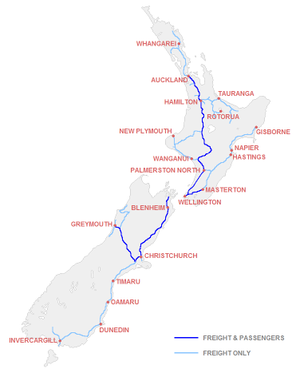Rail transport in New Zealand
| Rail transport in New Zealand | |||||
|---|---|---|---|---|---|

|
|||||
| Operation | |||||
| National railway | KiwiRail | ||||
| Infrastructure company |
New Zealand Railways Corporation (land) KiwiRail (track) Dunedin Railways Various heritage operators |
||||
| Major operators |
KiwiRail Scenic Journeys Transdev Wellington Transdev Auckland Dunedin Railways |
||||
| Statistics | |||||
| Ridership | 26.36m passengers per annum 13.92m Auckland commuter 12.13m Wellington commuter 0.31m KiwiRail Scenic |
||||
| Freight | 17.2m tonnes (2013–12) 4.49m net tonne kilometres (2012–13) |
||||
| System length | |||||
| Total | 4,128 km (2,565 mi) | ||||
| Double track | 252 km (157 mi) | ||||
| Electrified | 589 km (366 mi) | ||||
| Freight only | 2,328 km (1,447 mi) | ||||
| Track gauge | |||||
| Main | 1,067 mm (3 ft 6 in) | ||||
| 1067 mm | 4,128 km (2,565 mi) | ||||
| Electrification | |||||
| Main | 25kV AC | ||||
| 25kV AC | 488 km (303 mi) | ||||
| 1500V DC | 101 km (63 mi) | ||||
| Features | |||||
| No. tunnels | 150 | ||||
| Tunnel length | 80 km (50 mi) | ||||
| Longest tunnel |
Freight Kaimai tunnel 8,879 m (29,131 ft) Passenger Rimutaka tunnel 8,798 m (28,865 ft) |
||||
| No. bridges | 1787 | ||||
| Longest bridge |
Freight Rakaia river bridge 1,743 m (5,719 ft) Passenger Waiau river bridge 700 m (2,300 ft) |
||||
| Highest elevation | 832 m (2,730 ft) | ||||
| at | Pokaka, North Island Main Trunk | ||||
|
|||||
| Map | |
|---|---|
 |
| New Zealand |
|---|
| Locomotives |
| Lines |
| Jargon |
| Preservation |
|
|
Rail transport in New Zealand consists of a network of 1,067 mm (3 ft 6 in) narrow gauge railway lines in both the North and South Islands. Rail services are focused primarily on freight, particularly bulk freight, with limited passenger services on some lines. Only Auckland and Wellington have urban rail systems, both of which are being upgraded and expanded.
The railway network was initially constructed by the provincial governments of New Zealand from 1863 onwards. New Zealand's first public railway was opened in that year at Ferrymead by the Canterbury Province. The first steam-powered railway operated between Christchurch and Ferrymead.
The Canterbury Provincial Railways were built to the broad gauge of 1,600 mm (5 ft 3 in). On 5 February 1867, Southland Province opened a branch from Invercargill to Bluff to the international standard gauge of 1,435 mm (4 ft 8 1⁄2 in). From 1870, the central government of Sir Julius Vogel proposed infrastructure including railway development, to be funded by overseas loans of £10 million. The central government also adopted a national gauge of 1,067 mm (3 ft 6 in). The first narrow-gauge line was opened on 1 January 1873 in the Otago Province, the Port Chalmers Branch under the auspices of the Dunedin and Port Chalmers Railway Company Limited. Auckland's first railway, between Auckland and Onehunga, opened in 1873. Vogel also arranged for Brogdens of England to undertake several rail construction contracts, to be built by "Brogden's Navvies" recruited in England.
...
Wikipedia

